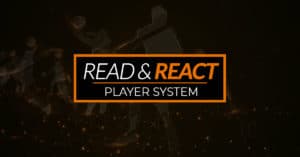I define a “situation” as an offensive action that engages two or more defenders simultaneously. For example, most screening actions create situations, an attacking drive generates a situation, and many times just feeding a competent post player instigates a situation.
If your opponent lacks cohesion as a defensive unit, a single situation may be enough to break them open for a score. The reality, though, is that most defensive teams are better coached and more prepared: they are capable of helping and recovering as well as double-teaming and rotating back without giving up a scoring opportunity.
But, just because a team can handle one situation doesn’t mean they can handle two or three in a row, or even two or three simultaneously.
Set this as a goal for your Read & React team (especially when you come up against better defensive teams): every possession, force the defense to handle more than one situation back to back or at the same time.
Below are a couple of examples of how you can do that.
Read & React Offensive Situations in a Row
Example 1: Feed the post, set a Pin Screen on the weak side, have the post skip the ball. That’s two situations in a row: the defense must handle the post feed and navigate a Pin & Skip in quick succession.
Example 2: Drive and pitch; screen the ball; then pass, cut, and set a screen for the post. Now the defense must help and recover on the drive; hedge, switch, or whatever they do against a pick and roll; and navigate a screen away from the ball in a “big-little” scenario. That’s at least three situations and will potentially create a couple more.
Even something as seemingly simple as two Pin & Skips in a row works. Or, two drive and pitches. The options are really endless and up to your team’s creativity and experience.
Read & React Offensive Situations at the Same Time
Example 1: Every time your post player deliberately posts up and asks for the ball, set a Pin & Skip on the other side of the floor, especially if the defensive strategy revolves around double-teaming the post. This forces the defense to decide which is more important: stopping the post feed or defending the Pin & Skip. Sure, they may be able to stop one, but can they stop both?
Example 2: Use an X-Cut after a post feed. That’s a simple way to generate simultaneous situations – the East/West screen with the ball in post. And, there’s going to be a basket cut coming along as well. Throw in a Pin screen on the opposite side of the floor and you have three or four simultaneous situations. That’s tough to defend.
When you’re trying to kill a snake that wants to bite you, throwing one rock at a time will preserve your supply of rocks but you might run out of time before you hit it. Why not throw a handful of rocks at one time? The odds of hitting the snake goes up dramatically!
It’s not a perfect analogy, but you get the point. One situation per possession is not enough to take down a good defensive opponent.








